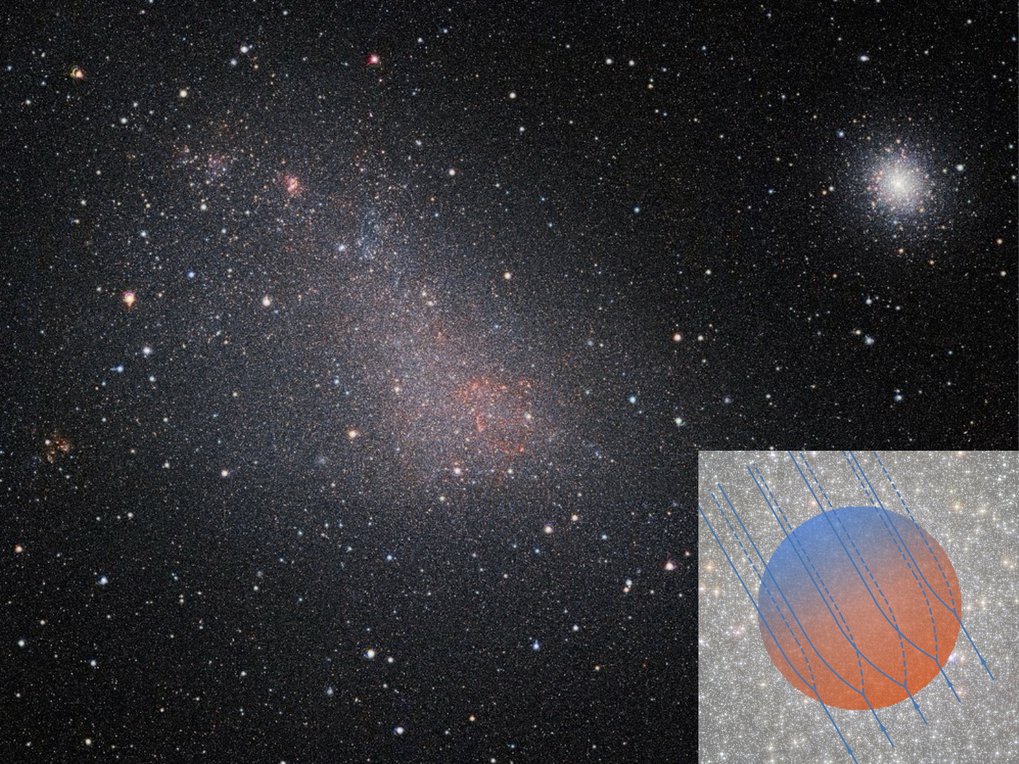Max Planck Institute for Radio Astronomy | 2020 Mar 02
Investigation of pulsars in 47 Tuc provides constraints on the magnetic field in the halo of the Milky Way
The Galactic magnetic field plays an important role in the evolution of our Galaxy, but its small-scale behaviour is still poorly known. It is also unknown whether it permeates the halo of the Galaxy or not. By using observations of pulsars in the halo globular cluster 47 Tuc, an international research team ... could probe the Galactic magnetic field at scales of a few light years for the first time. They discovered an unexpected strong magnetic field in the direction of the cluster. This magnetic field points perpendicularly to the Galactic disk and could be explained by an interaction with the Galactic wind. This is a magnetized outflow that extends from the Galactic disk into the surrounding halo and its existence has never been proven before. ...
- Globular cluster 47 Tuc (upper right) and the Small Magellanic Cloud in the same field-of-view. The inset is a close-up of the cluster showing the detected magnetic field in a colour scale. The lines indicate the effect of the Galactic wind on the magnetic field. © ESO/VISTA VMC (background image); F. Abbate et al., 2020, Nature Astronomy (inset)
47 Tucanae, or 47 Tuc as it is usually called, is a spectacular globular cluster visible with the naked eye in the constellation “Tucana” in the southern sky close to the Small Magellanic Cloud. The first pulsar in this cluster was discovered in 1990 with the Parkes 64-m radio telescope in Australia, and soon more were found with the same telescope. Currently there are 25 pulsars known in 47 Tuc. For this reason, this very well-studied globular cluster became one of the most important for pulsar astronomers as well.
Pulsars are periodic sources that allow astronomers to measure the so-called dispersion measure which is a delay of the arrival time of the single pulses at different frequencies. This delay is proportional to the density of free electrons along the path from the pulsar to the Earth. “In 2001, we noticed that the pulsars in the far side of the cluster had a higher dispersion measure than those in the near side, which implied the presence of gas in the cluster”, says Paulo Freire ...
What makes 47 Tuc even more interesting is that the cluster is at a distance of about 15,000 light years, located in a relatively undisturbed area in the Galactic halo. The halo surrounds the Galactic disk and hosts very few stars and very small quantities of gas. “The pulsars in this cluster can give us a unique and unprecedented insight into the large-scale geometry of the magnetic field in the Galactic halo.” says Federico Abbate ...
Constraints on the Magnetic Field in the Galactic Halo from Globular Cluster Pulsars ~ Federico Abbate et al
- Nature Astronomy (online 02 Mar 2020) DOI: 10.1038/s41550-020-1030-6
